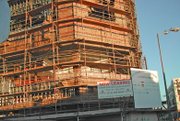New Wave of Real Estate Growth Powers L.A. Juniors Biz
The intersection of 12th and Stanford streets in downtown Los Angeles is dusty and cramped with narrow two-lane streets that are overshadowed by tiers of scaffolding from new construction. It’s not pretty right now, but developer Shawn Zackary envisions the scene otherwise.
“This is the new Fashion District,” said the developer, whose Falcon California Inc. is putting the finishing touches on the 109-unit open-air Stanford Wholesale Mart. The mostly juniors apparel mart is about two months from its ribbon cutting. When completed, it will be one of many apparel buildings constructed over the past few years, and Zackary envisions further growth in this section of Los Angeles. He’s planning another project across the street.
The developer, whose second career is with Paramount Textiles nearby, knows this section of town. He reacted when he saw the wholesale market around San Pedro Street migrating east. Many of the small showrooms that are spread out west of Stanford along Wall Street and nearby have lost business to more-centralized projects. Several have relocated to newer projects such as the Stanford mart.
The San Pedro Wholesale Mart set the pace a few years ago with its condominium-style showrooms set under one roof, featuring mostly juniors fashions from Los Angeles’ large Korean-American manufacturing community. The area west of San Pedro has more or less been dominated by discount retailers, so the only place to build is east of San Pedro.
Zackary’s new mart should benefit from feeder traffic from the San Pedro and neighboring marts.
“There are two alleys being built that lead directly to our project,” he said. Across the street is another project under development by a private company.
“We see this as a premier location. Buyers will be able to visit 200 to 300 showrooms without being in a mall,” he said.
Much of the traffic is fueled by Latin American buyers looking for better juniors goods. It’s also a key source for top American juniors brands for private-label resources,” said Zackary, who rattled off a list of well-known labels sold in department and brand-owned stores.
The small showrooms in this area are somewhat deceiving, he said. Many are backed by companies with 100,000- to 200,000-square-foot warehouses in other parts of the city. Others are connected to large factories in China, Korea and other parts of Asia, Zackary noted.
The Stanford Wholesale Mart, located at 813 E. 12th St., is 80 percent leased on the first level and 60 percent leased on the second level. Units will range from 700 to 1,500 square feet. Leases are from $3 to $12 per square foot. Commercial tenants signed on include Nara Bank and several restaurants. The units will feature 18-foot ceilings, and the mall will open up to an escalator entrance with a giant LED screen.
Projects such as Zackary’s are prompting the Los Angeles Fashion District Business Improvement District to explore annexing the area into the Fashion District so it can receive services such as security, marketing and refuse hauling.
“We are in the renewal process,” explained Kent Smith, executive director of the BID. “We are looking at taking the area up to Paloma Street.”
The annexation process will take place in 2008 and, if approved, will go into effect in January 2009, said Smith. The BID annexed the area between San Pedro and Crocker streets during the last renewal.
“There is still a lot happening,” Smith said. “A lot of people wondered about the potential when the [Santee] alley opened in the ’70s. We are seeing wholesale jobs on the increase, and as long as California stays on top of its game, you’re going to see growth and success.”
Zackary said sales in this part of Los Angeles are growing 20 percent to 30 percent a year.
“It will soon catch up to New York in sales volume,” he said. “There’s so much room to grow. This is just the beginning.”























